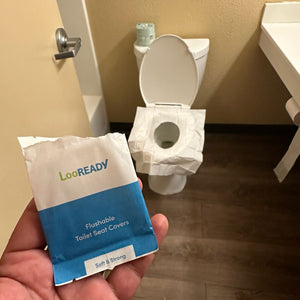The Unsung Heroes of Hygiene: Public Toilets Get Their Due Recognition
Let’s be honest—public toilets don’t exactly get the respect they deserve. They’re there when you need them, often taken for granted, and sometimes feared more than necessary. But in recent years, public toilets have found themselves in the limelight, with improved standards, award-winning designs, and a growing body of research proving that proper hygiene in these spaces is crucial for public health.
The UK's "Loo of the Year Awards" has been recognizing top-tier public restrooms for decades, and 2025 saw Scotland take the crown. The Centre Livingston in Scotland was named the best public toilet in the UK, outshining even the royal facilities at Sandringham Estate (STV News).
It’s not just about a clean seat and a full roll of toilet paper anymore. The standards for public toilets are being raised, and for good reason—science is catching up to the reality that public toilets are a major source of pathogenic spread.
From ‘Harmless’ to High-Risk: The New Science of Public Toilet Hygiene
Prior to the Covid pandemic, it was widely believed that sitting on a public toilet was relatively harmless. If you didn’t see visible dirt, you were probably fine, right? Well, new research suggests otherwise.
Spreading germs can happen anywhere—shaking someone’s hand, touching a door handle, or using public transportation. But it’s difficult to pinpoint exactly where we pick up viruses. However, we do know where they spread most easily.
For example, scientific studies confirm that flu and cold viruses spread more easily in winter due to people gathering in enclosed spaces with less ventilation. Now, there is overwhelming evidence that public toilets—especially those with poor ventilation—are hotspots for pathogenic spread.
A key factor? The toilet plume.
Every time a toilet is flushed, an aerosolized plume of toilet water rises into the air and settles on surfaces. This plume can carry bacteria, viral matter, fecal particles, and even urine. If the restroom has poor ventilation, these particles linger in the air and settle on exposed surfaces—including the toilet seat and paper toilet seat covers in dispensers.
This is where LooREADY provides a unique solution. Unlike traditional paper seat covers, which absorb moisture and do little to prevent contact with contaminated surfaces, LooREADY’s Ecopolymer Technology creates a protective barrier that is impermeable to the microscopic contaminants found in public restrooms. Compact, easy to carry, and dissolvable, LooREADY offers peace of mind in public toilets—and is water-soluble, formulated to lubricate pipes and disperse grease, oils, and fats to help alleviate toilet blockages and reduce maintenance costs.
Learn more about the science behind public toilet hygiene here.
The UK’s Public Restrooms: A Battle Between Clean and Contaminated
Not all public restrooms are created equal. Some receive top honors (like Livingston’s award-winning loos), while others… well, let’s just say they could use a deep clean.
In 2022, a UK-wide survey revealed that London had the highest number of unclean public bathrooms, with 42% of Londoners reporting that at least half of the public toilets they visited were dirty (Airdri). Shopping centres and train stations were among the worst offenders, highlighting the need for better sanitation management in high-traffic areas.
Public dissatisfaction with restroom facilities is a growing concern. A consumer research campaign in 2022 found that over a third of UK adults were unhappy with public toilets in their local area. Even more concerning? 77% of Londoners said they struggled to find a public toilet when they needed one (Citron Hygiene).
The lack of accessible, hygienic toilets is a serious issue—not just for convenience, but for public health.
Are Public Toilets Making Us Sick? What the Experts Say
The British Journal of Nursing recently explored the health risks associated with public restrooms, emphasizing that they must be designed to support proper hygiene practices—particularly for menstruation management, handwashing, and overall sanitation (British Journal of Nursing).
Health and safety guidelines emphasize the importance of well-maintained public facilities. The Health and Safety Executive (HSE) states that workplaces must provide adequate, flushing toilets with running water and that relying on public toilets for employee use is unacceptable if on-site facilities are possible (HSE).
The Future of Public Toilets: Innovations and Trends
There is a silver lining. While public toilet hygiene has been a concern, there are promising innovations reshaping the future of these essential facilities.
-
Scotland’s Loo of the Year proves that public restrooms can meet exceptional cleanliness standards.
-
Self-cleaning toilets and touchless technology are reducing contamination risks in high-traffic areas.
-
Ventilation upgrades are becoming a key focus in restroom redesigns to mitigate airborne bacteria.
-
Eco-friendly restroom solutions are gaining popularity, balancing sustainability with hygiene.
Final Flush: What This Means for You
Public toilet hygiene has taken centre stage, and for good reason. Whether you're using an award-winning restroom or one that makes you reconsider your choices, awareness is key. The more we understand about hygiene risks, the better we can protect ourselves and demand higher standards for public restrooms.
So, next time you enter a public toilet, take a moment to appreciate the science behind sanitation. And if you happen to be in Scotland, perhaps pay a visit to the cleanest public restroom in the UK—it might just be worth the trip!
Stay safe, stay clean, and remember: hygiene starts before you flush.

